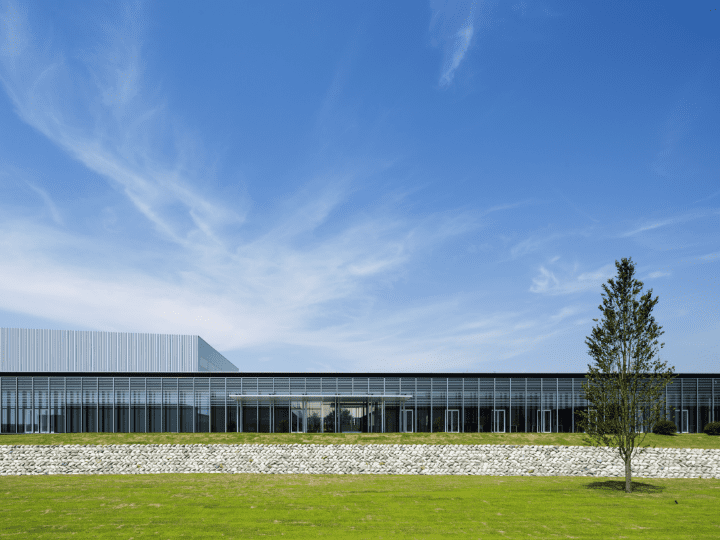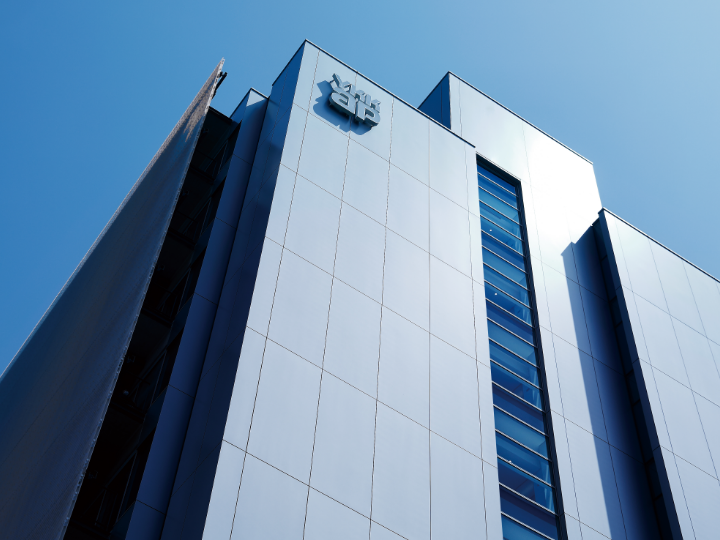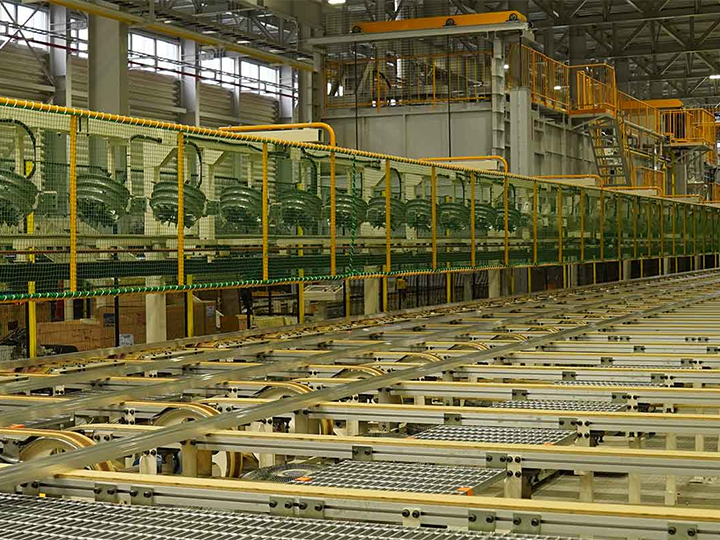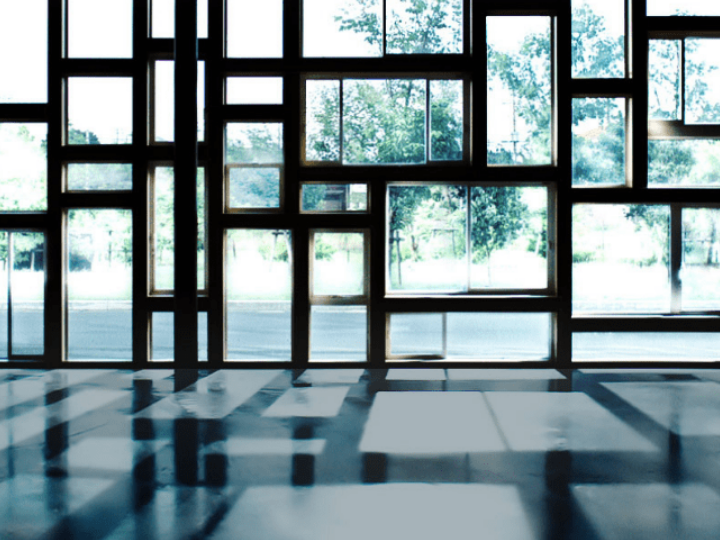
YKK AP’s resource recycling actions: active efforts to implement environmental management with the aim of zero environmental impacts by 2050
"We Build a Better Society Through Architectural Products." This is YKK AP’s Purpose and the meaning of our existence as we conduct our business of developing, manufacturing, and selling windows, doors, interior and exterior products, curtain walls, and other items. YKK AP is carrying out initiatives for co-existence with the environment to build a sustainable society.
"Evolution 2030," YKK AP’s Vision, states that the company will "Contribute to the Global Environment: Create mechanisms toward the realization of decarbonization and a circular society." YKK AP’s goal for 2050 is to "achieve zero environmental burdens through the entire lifecycles within its business activities." In its 6th Mid-term Environmental Business Plan, YKK AP sets and is working to achieve targets for four environmental issues: climate change, resource recycling, water, and biodiversity. Among these, one resource recycling goal is to reach a 100% internal recycling rate for vinyl windows (APW scraps) in Japan. YKK AP is analyzing factors involved in waste generation and utilizing sustainable resources to reduce the amount of waste created throughout product lifecycles.

For example, some of YKK AP’s initiatives are as follows.
- Using compactors to reduce foam insulation scrap volume by 93%, then recycling these scraps
- Returning acrylic scraps to manufacturing companies so they can be reused in raw materials for YKK AP’s acrylic materials
- Four plants in Toyama Prefecture are working together to collect waste and manufacture 191 tons of densified fuel (FY2022)
Naoya Tsuruga is in charge of environmental facility management at the Kurobe Ogyu Plant in the City of Kurobe, Toyama Prefecture. He spoke about resource recycling for foam insulation and acrylic material.
Material recycling to reuse waste matter as raw materials
The Kurobe Ogyu Plant manufactures products including windows for residential buildings, window shutters, entrance doors, sliding doors, and interior architectural products. In FY2022, we successfully reduced the amount of production process waste by 50.6% compared to FY2013, mainly plastic, glass, and wood scraps. We will keep working at the Kurobe Ogyu Plant to decrease this amount by implementing material recycling, which reuses waste matter as raw materials.

Recycling 47 tons of foam insulation per year
One of our initiatives is material recycling for product components. Synthetic vinyl foam insulation is used in the Venato D30, an entrance door with thermal insulation. The foam insulation is processed according to the door shape, including its size and design. This processing generates four tons of scraps every month, totaling approximately 47 tons a year. The scraps are very bulky and require a lot of storage space. We had to collect this waste frequently because it is produced in large quantities every day, and to spend huge amounts of money for it to be transported and collected.
Foam insulation is a recyclable material, but there are some challenges to handling it. It can’t be made into plastic material as-is because there is lots of air inside. And since foam insulation is so light, it’s not easy to deal with the broken pieces that can fly around and remain in the crusher. Processing fees are higher than plastic for this reason. People said that material recycling and resource recovery would be difficult for foam insulation.

Entrance door cross section (containing foam insulation)
Compacting foam insulation to reduce its volume to 10% or lower
At the Kurobe Ogyu Plant, we use a compacter to compress Foam insulation scraps during the manufacturing process. We carry out material recycling by collecting this raw material and processing it into a shape that is simple to reuse. The Foam insulation is broken into small pieces in the compactor, then heated to remove air and form highly dense ingots with just 7% of their original volume (a compression ratio of 93%). These ingots are simple to store and transport, and also easier to process and handle. Each week, we produce enough ingots to fill four bags that hold one cubic meter each. This valuable material is sold to companies that deal in plastic materials for food trays and other products.


Compacted foam insulation scraps are compressed to save space for easy handling
Reusing waste for product manufacturing
Another initiative is waste material recycling. Acrylic scraps from manufacturing are recycled and used as acrylic material. Screen partitions, a type of interior architectural product used to divide up rooms, are made from acrylic material. The scraps created from the manufacturing process are all collected for material recycling. Acrylic scraps with specified product numbers are returned to the manufacturing company and used in raw materials for YKK AP’s acrylic materials. We send back roughly 26 tons of acrylic material to manufacturers each year, which helps recycle and effectively utilize resources. However, we struggled with quality management for acrylic materials that are returned. Obviously, this is because manufacturers will not take back materials containing any impurities. During these discussions, manufacturers asked us to rethink our means of handling these materials, because they could not use acrylic scraps with dust or those that had become discolored. We revised our classification standard to create a collection structure according to our plan. We handle these materials carefully to make sure the protective film stays in place to protect them from dust. Steps for inspecting and checking the collected scraps were added to the process, and we made thorough efforts to ensure that on-site workers (including those in charge of labeling) are aware of this.

Adding value to waste material
The Kurobe Ogyu Plant has a recycling rate of 100% for foam insulation and acrylic material. However, there are still resource recycling issues. Waste is becoming more diverse and difficult to process due to composite and newly developed materials. Resource recovery may be possible for items that cannot be recycled as-is—we may be able to give them added value, such as by compacting them or sorting materials that are usable. Going forward, I think it will be important for us to do our own pre-processing and treatment, without hiring outside parties to process waste and valuable materials.

Turning waste into densified fuel
In addition to YKK AP’s material recycling for plastic waste, the Kurobe Ekko Plant is working to reduce waste by turning plastic scraps into valuable material. Osamu Araki, head of the Safety and Environmental Management Office, is in charge of the Kurobe Ekko Plant’s environmental management facility. He spoke about these initiatives.
The Kurobe Ekko Plant is a major production site for screws, handles, door screens, and many other components. Just like the Kurobe Ogyu Plant, our production processes generate a lot of waste, such as plastic and glass scraps. Between FY2013 and FY2022, we decreased this amount by 57% via thorough waste sorting and other efforts. For further reductions in the future, we are focusing on RPF manufacturing that turns waste into densified fuel.
RPF stands for "refuse-derived paper and plastic densified fuel." RPF manufacturing lets us turn our waste into valuable material that can be sold. It also contributes to carbon neutrality by reducing fossil fuels. At the Kurobe Ekko Plant, the main raw material is waste from rubber gaskets, which are used to attach window glass to sashes. We crush this raw material and utilize a sorting machine that removes foreign materials, then heat it and compress it in a forming machine to make RPF. Nearly 100% of the waste we put in the machine is recyclable.


RPF manufacturing equipment
One plant isn’t enough to manufacture RPF
When we were going to install the RPF manufacturing equipment, we realized it would be difficult to fully utilize its production capabilities with the amount of waste from the Kurobe Ekko Plant alone. We came up with a plan to collect waste for RPF manufacturing together with other plants in Toyama: the Kurobe, Kurobe Ogyu, and Namerikawa Plants. Some people were anxious about introducing this equipment, but I personally visited each plant to gather samples and determine if their waste could actually be used as raw materials for RPF. Through these actions, I got the plants on board with the plan, and people began demonstrating a will to work together to accomplish what we had all decided.
Struggling to come up with the ideal RPF “recipe”
We also struggled with determining a "recipe" for the RPF desired by our customers. RPF burns in different ways depending on the ratio of materials used to make it. For instance, our business partners can’t use RPF with a lot of paper in their equipment, because it burns too quickly. RPF with a large amount of gasket scraps emits sulfur oxide (SOx), which causes air pollution.
The recipe becomes increasingly complex as you add more types of waste. We had to create RPF prototypes combining waste material from the four plants to analyze whether they burned as we wished. Through a repeated series of trial and analysis, we came up with the final recipe of 30% soft plastic waste, 30% hard plastic waste, and 40% paper. We build a system to collect 40% of this waste from the Kurobe Plant, 30% from the Kurobe Ekko Plant, 25% from the Kurobe Ogyu Plant, and 5% from the Namerikawa Plant.

Collecting waste from nearby plants

Crushing and compacting waste according to the recipe
Producing more RPF than we imagined
In February 2022, we successfully introduced RPF manufacturing equipment (with a production capacity of 150 kg/h) according to this waste collection system and recipe. Since then, these activities have become established as an integrated effort by the four plants, based on the goal of experiencing these waste-reduction effects. In FY2022, we exceeded our original target of 155 tons by producing and selling 191 tons of RPF. Our plan was to produce 203 tons in FY2023, but we are considering a final number of 300 tons after expanding the collection structure to all plants across Japan. There are still some issues to solve, such as receiving waste transport approval and determining transport costs, but I am hoping to create value throughout our overall manufacturing, not just in our region. We are also considering using the RPF we manufacture in house, such as by burning it in plant boilers.

RPF
Actively creating environmental value
As the environmental manager of a plant, I can say that this high level of capital investment is possible because the company has a clear Environmental Policy on resource recycling. Safety and environmental management involves standards that absolutely must be met regarding society and risk-related compliance. Of course I want to have a good defensive stance, but I also intend to take active, bold steps for even better environmental management. If not, it will be difficult to exceed our lofty environmental targets for 2030 and 2050. Bases that are able to will volunteer to serve leading roles and draw others in to help solve environmental issues.

YKK AP is working to reduce our environmental impacts so it can create new environmental value at all stages of the lifecycle, with the aim of achieving its vision for 2050. In April 2023, YKK AP was certified as an Eco-First Company in the Eco-First Program run by the Ministry of the Environment, and recognized as a company engaged in advanced, unique, industry-leading business activities in the environmental field for declaring that it will take on these initiatives as part of its Eco-First Commitments. YKK AP will continue striving to create new value through technological innovation to build a better society and environment for future generations.

Naoya Tsuruga
Joined YKK AP as a mid-career hire in 2004. Worked on line and production improvement in the Production Technology Office, Entrance Manufacturing Department, Kurobe Ogyu Plant.
Transferred to the Environmental Facility Management Office in 2007. He is currently the main person in charge of promoting energy saving, waste management, and compliance with environmental laws and regulations at the Kurobe Ogyu Plant. In the field of waste management, he works to achieve zero waste sent to landfills, decrease waste from manufacturing processes, and promote recycling.

Osamu Araki
Began working at YKK AP in 1985 in component manufacturing, production technology, line management, and production management at the Kurobe Ekko Plant.
Was assigned to his current role in FY2018. Is in charge of safety, health, environmental, and facility management at the Kurobe Ekko Plant.
Share this article
- SNS Link X X Share
- SNS Link Facebook Facebook Share
- SNS Link LinkedIn LinkedIn Share
- SNS Link LINE LINE Share
- Copy Link Copy Link Copy Link Copied Link
Related stories
-

The Evolution of the Aluminum Profile Department into the Automotive Industry’s Manufacturer of Choice
- Aluminum Profile
- Technology
- Sustainability
- Solving Social Issues
-

Toward Achieving Carbon Neutrality: Taking on the Challenge of 100% Aluminum Recycling by a Window Manufacturer
- Technology
- Manufacturing
- Environment
- Sustainability
-

Stop the Landfill Disposal of Used Vinyl Windows! Disseminating Vision for Vinyl Window Recycling Through Industry-Government-Academia Collaboration, and Taking on the Challenge of "Window-to-Window" Recycling
- Technology
- Manufacturing
- Environment
- Solving Social Issues








